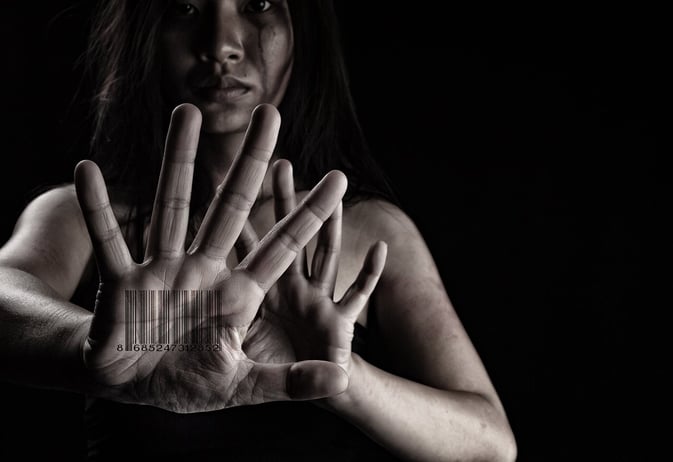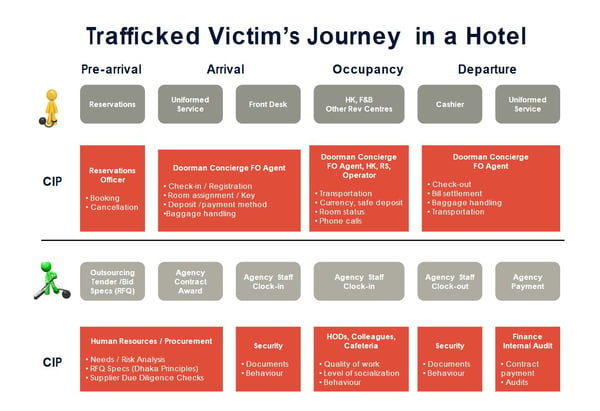The EHL Women in Leadership (WIL) Expert Series had the privilege to welcome Prof. Dr. Maureen Brookes of the Oxford School of Hospitality Management (Oxford Brookes University) to share her expertise on the topic of human trafficking. Drawing on her research, which has been funded by the European Commission, she helped our audience to understand why hotels are vulnerable to human trafficking and how to identify the critical intervention points within hotels where signs of trafficking can be spotted and preventative measures can be put in place. Prof. Brookes also shared with us her knowledge in combating human trafficking in order to protect hotel businesses and support victims.
What is human trafficking?
Human trafficking is analogous to a more modern form of slavery. It involves the recruitment, movement, and exploitation of human beings. Vulnerable individuals are more likely to be recruited via coercion or deception, who then are isolated from their environment in order to be easily controlled and finally exploited.
Today, there are more slaves than in any other time of human history. The Walk Free Foundation’s Global Slavery Index (2018) estimates 45.8 million victims of human trafficking worldwide, of which 71% are women. And the numbers continue to rise as human trafficking is one of the fastest growing criminal activities, third only to drugs and arms trafficking.
Several factors are fueling human trafficking, including:
- Increasing migration due to economic disparities between countries;
- Lack of punitive measures (e.g. in the UK only 1% of the victims see their traffickers convicted in a court of law);
- And disturbingly high profit and ludicrously low cost of “buying” a human being. The average cost of a slave is USD 90, whereas the average annual profit of a single trafficked woman for sex is USD 100,000. In fact, the ROI in the area of sexual exploitation is 100%-1,000% and forced labour is 50%. Globally, the annual profit of human trafficking is USD 32 billion.
Download the ‘Combat Human Trafficking’ toolkit
Human trafficking in the hotel industry
The hospitality industry is highly vulnerable to human traffickers especially when it comes to child sexual exploitation and forced prostitution, forced criminality, domestic servitude, and forced labour in hotels (or in their supply chains). Research estimates that there are 1.14 million victims in the European hospitality industry (80% for sexual exploitation and 20% for forced labour in restaurants, bars and hotels).
Why are hotels vulnerable to human trafficking?
Because their revenue streams and operations are increasingly being automated. For example, automatic check-ins/check-outs, third party reservation systems, non-mandatory registration and identification, guest privacy and anonymity all prevent hoteliers and staff members from knowing the real identity of their customers or what they are doing behind closed doors.
Employment practices and corporate culture also facilitate human trafficking, including: priority of meeting customers’ requests that exceed ethical boundaries, lack of background checks on new employees, lack of awareness of employees and lack of training to spot signs, fear of retribution by staff if they report suspected incidents, and lack of clear measures to address human trafficking.
Knowing the signs of human trafficking for hotel staff
There are numerous signs that staff should be trained to recognize along a trafficked victim’s journey in a hotel. For example, forced labour victims are usually isolated and unwilling to socialize, often volunteer to work during social functions, and do overtime shifts as much as possible. Independently, these behaviours do not reveal much, yet taken together they paint a clear picture of a trafficked human being.
There are primarily two journeys in a hotel: sexual exploitation and forced labour. Hoteliers must identify the critical intervention points (CIP) within their establishments in order to effectively build safeguards and employees must pay attention (and be empowered to act) to these points (see figure 1).
Building safeguards in hotels to prevent human trafficking
So what can be done? The Combat Human Trafficking Toolkit developed by Prof. Brookes and colleagues includes measures that can be taken at three levels of management
At the Senior management level: Use maps showing smuggling and trafficking routes and pinpoint the properties in their portfolio close to them, in order to prevent human trafficking. An increasing number of senior managers use criminal heat maps displaying properties’ various levels of risk per category. This system provides them with an efficient control tool.
At the corporate management level: Develop anti-trafficking policies (including supply chains) and monitor their effectiveness by using KPIs such as number of anti-human trafficking training programs offered and attendance, number of properties that have undergone a risk assessment for human trafficking per year, number of suspected cases reported internally. Corporate management can also work closely with the police or independent bodies to prevent this crime and support the victims.
At the operational level: Create barriers such as full reference checks for all new recruits (including address and bank details in salary checks), engage in conversations with new recruits, and implement a buddy system to ensure interactions between all employees and regular staff training and awareness campaigns.
Human trafficking in hotels is associated with legal risks including complicity, operational risks such as business disruption, reputational risks linked to financial implications, and most importantly to ethical and moral risk, as human trafficking is a crime against humanity.
For more on how to effectively combat human trafficking you can reach directly Prof. Dr. Maureen Brookes.







